stamp pictures and values antique
antique stamps pictures
What are they?
Referred to as the "tax stamp," images specially marked by these government seals are often quite desirable to collectors.When were they first used?
Faced with the financial demands of the Civil War, our Federal government issued the Revenue Act of 1862. This Act created ways to raise new revenue, as well as formed the Department of Internal Revenue. Nearly every kind of document was taxed (including deeds, insurance policies, telegrams, stock certificates, etc) and what were considered luxuries (such as playing cards, liquor, tobacco, matches, perfume.) Revenue stamps were designed to affix to these various items proving that the tax had been paid. Not enough!An act of Congress passed on June 30, 1864 placed a new tax on "photographs, ambrotypes, daguerreotypes or any other sun-pictures." Photographers were required to affix a properly denominated revenue stamp on the back of the image and cancel it by initialing and dating it in pen. There was not a special stamp created for photography, thus you will see stamps on images for Bank Checks, Playing Cards, Certificates, Bill of Lading, etc. These were accepted by the Federal Government as long as the denomination was appropriate.
How much was the tax?
The amount of tax paid was determined by the cost of the image.Less than 25 cents: 2 cents stamps (blue/orange).
25 to 50 cents: 3 cents stamps (green).
50 cents to $1: 5 cents stamps (red).
More than $1: 5 cents for each additional dollar or fraction thereof
The majority of images, particularly cdvs and tintypes, cost between 25 and 50 cents. Thus you will most likely find 2 or 3 cent stamps affixed to them. Most of these stamps feature the head of George Washington, and are found in orange, red, blue, or green. The rarest is the red one cent "playing card" stamp, and the most common is the orange two cent "playing card" example. In March of 1865, there was a reduction of tax to one cent on the under-10 cent images.
What about the writing or marks on the stamps?
As mentioned above, photographers were given directions about how to cancel the revenue stamps. Some photographers followed the law to the letter, and you will find neat initials and dates penned on the stamp. 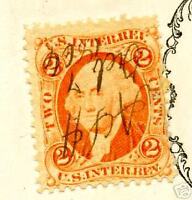
Other photographers adapted the law to suit their needs, including using rubber stamps giving name and date 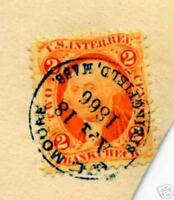 by the larger studios that produced many images per day. You will often find a simple "X" or hash marks
by the larger studios that produced many images per day. You will often find a simple "X" or hash marks  or no cancellation at all!
or no cancellation at all!  Practices varied.
Practices varied.
When did the tax end?
The stamp tax on photographs was repealed on August 1, 1866 and revenue stamps no longer appeared on images after that date. Thus, you will not find tax stamps on cabinet card images, which became popular after this date.
Why are tax stamps on images desirable?
Tax stamps help us identify exactly what time period an image was created, in some cases down to the day! They mark images as specifically "Civil War era." Additionally, it is most interesting to be able to see the hand of the photographer on his work in the form of initials, signatures, and flourishes (although keep in mind that assistants may have performed the actual cancellation.) Some tax stamps are rare and unusual, and desired by philatelists. It is also interesting to determine what people paid for their likenesses 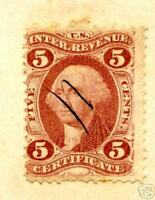 and how prices varied between parts of the country, and between city and more rural areas.
and how prices varied between parts of the country, and between city and more rural areas.
Anything else?
In some cases, the owner or recipient of the image may have peeled off the tax stamp, or it may have lost its adhesive qualities and separated. You will sometimes find a gummed shadow where the stamp was affixed at one time, or remnants of it left behind by someone who tried to scrape or peel it off. 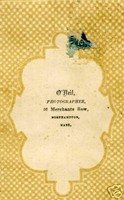 Though it may be sad to lose the stamp, the demarkation can help you estimate the time period that the image was created in.
Though it may be sad to lose the stamp, the demarkation can help you estimate the time period that the image was created in.
Another interesting finding on some photo backs is a little box imprinted to specifically hold the tax stamp 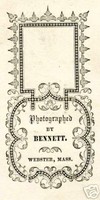 Some photographers perhaps thought the tax was there to stay, and ordered card stock to neaten the appearance of their backmark.
Some photographers perhaps thought the tax was there to stay, and ordered card stock to neaten the appearance of their backmark.
Hiç yorum yok:
Yorum Gönder